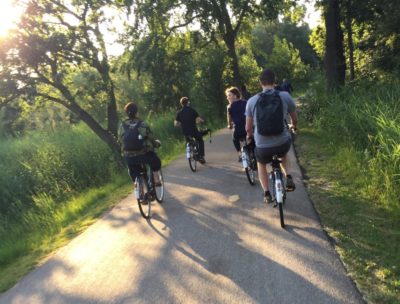
Most Americans find driving quite irresistible. Yet we generally don’t think about the policies and infrastructure that have shaped our travel behavior in the United States. Americans make only about 1 percent of their trips by bike and about 10 percent by foot. This is in marked contrast to much of the rest of the world.
At the heart of Americans’ driving habits are a number of factors: the design of our cities and neighborhoods; the lack of safe, attractive and convenient facilities to bike and walk; and the array of incentives for driving— such as low fuel prices, free parking, abundant and unpriced road capacity. But it is possible to make biking and walking a compelling option to driving.
Check out this 4-minute video about what it takes to help lots of people bike and walk.
Irresistible Infrastructure

Separate or protected cycling facilities are a key to getting lots of people biking. This is especially true along heavily traveled roads and at intersections. In most residential neighborhoods, traffic calming helps. U.S. planners have recently begun to realize that few people will bike on a road shoulder, which has been standard bike infrastructure in the U.S. The chart below shows the type of bike facilities required to inspire people to choose to bike instead of to drive.

Types of cyclists

The American Association of State Highway and Transportation Officials has delineated three types of people who bike. Highly Confident, Somewhat Confident, and Interested but Concerned. As shown in their chart above, over half the population is Interested but Concerned. A Portland official noted that this last category is comprised of people who “would like to ride more but they are afraid to ride. … They would ride if they felt safer on the roadways—if cars were slower and less frequent, and if there were more quiet streets with few cars and paths without any cars at all.”
All Ages and Abilities
All Ages and Abilities biking and walking infrastructure (AAA) refers to infrastructure that meets the needs of young and old, athletic or casually active. Obviously actual physical safety is critical, but AAA recognizes that even infrastructure that is technically safe from a statistical perspective can feel unsafe or at least uncomfortable. This AAA approach is often called “low stress” infrastructure. Many are inspired by the “8-80 Cities” approach championed by Gil Penalosa and others. An 8-80 city is one that’s easy to navigate for 8-year-olds and 80-year-olds.

Making Going on Foot Compelling
People going on foot for transportation have needs similar to those using a bike. They need low stress, attractive and convenient infrastructure. Detailed information regarding needs of people who go on foot can be found here.
